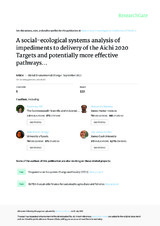Mostrar el registro sencillo del ítem
A social–ecological systems analysis of impediments to delivery of the Aichi 2020 Targets and potentially more effective pathways to the conservation of biodiversity
| dc.contributor.author | Hill, R. | |
| dc.contributor.author | Dyer, G.A. | |
| dc.contributor.author | Lozada-Ellison, L.M. | |
| dc.contributor.author | Gimona, A. | |
| dc.contributor.author | Muñoz-Rojas, J. | |
| dc.contributor.author | Gordon, I.J. | |
| dc.contributor.author | Martín-Ortega, Julia | |
| dc.date.accessioned | 2017-02-10T09:18:24Z | |
| dc.date.available | 2017-02-10T09:18:24Z | |
| dc.date.issued | 2015 | |
| dc.identifier.uri | http://hdl.handle.net/10396/14517 | |
| dc.description.abstract | The Aichi 2020 Targets, under the Convention on Biological Diversity (CBD), aim to halt the loss of biodiversity by 2020, in order to ensure that ecosystems continue to provide essential services. Here we apply a social–ecological systems analysis to provide insight into the diverse system interactions that pose impediments to delivery of the Aichi Targets. We applied an analytical framework of pair-wise exchanges along six axes between the social, economic, environmental and political loci of the global social–ecological system. The analysis identified that many impediments result from partial decoupling in the system through phenomena including delayed feedbacks and insufficient information flows. It suggests 15 of the Aichi Targets are unlikely to be delivered; 3 are likely to be delivered in part; and 2 in full. We considered how interventions at leverage points may overcome the impediments, and compared these to actions included within the Implementation Decision for the Aichi Targets, to find gaps. These new leverage points to fill identified gaps involve many aspects of system re-coupling: co-production of knowledge and more equitable food systems governance (environmental–social axis); support for social change movements (social–political axis); an appropriate financial target for biodiversity conservation investment, with a clear means of implementation such as a currency transaction tax (economic– political axis); and co-governance of natural resources (environmental–political axis). The recently released Global Biodiversity Outlook 4 shows that 18 of the 20 Aichi Targets are tracking in accordance with our analysis; and that current efforts are unlikely to result in an improvement in the base state of biodiversity by 2020, confirming some of our results. We argue that attention to the interactions within, and the partial decoupling of, the global social–ecological system provides new insights, and is worthy of further attention both for delivery of the Aichi Targets and for guiding longer term actions for the conservation of biodiversity | es_ES |
| dc.format.mimetype | application/pdf | es_ES |
| dc.language.iso | eng | es_ES |
| dc.publisher | Elsevier | es_ES |
| dc.rights | https://creativecommons.org/licenses/by-nc-nd/4.0/ | es_ES |
| dc.source | Global Environmental Change 34, 22-34 (2015) | es_ES |
| dc.subject | Aichi targets biodiversity | es_ES |
| dc.subject | Political ecology | es_ES |
| dc.subject | Power Social-ecological systems | es_ES |
| dc.subject | Environmentalists'paradox | es_ES |
| dc.title | A social–ecological systems analysis of impediments to delivery of the Aichi 2020 Targets and potentially more effective pathways to the conservation of biodiversity | es_ES |
| dc.type | info:eu-repo/semantics/article | es_ES |
| dc.rights.accessRights | info:eu-repo/semantics/openAccess | es_ES |

